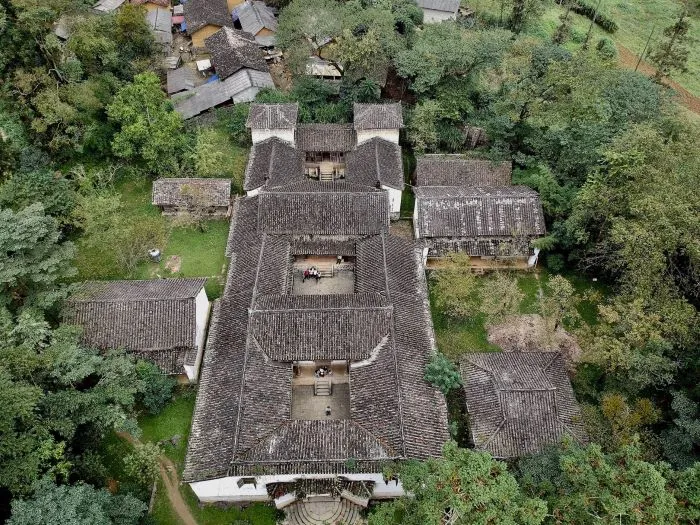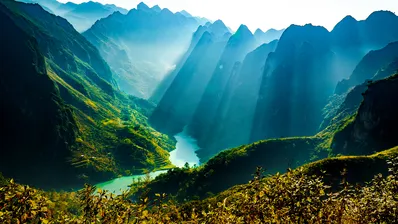Hmong Kings’ Palace also known as Dinh Vua Meo is a grand construction built in the late 19th century with distinctive architecture that combines many cultures and mysterious stories concerning. Explore with us the impressive beauty in the Hmong Kings’ Palace to know why it becomes a special tourist destination.
General information about the Hmong King's Palace
Also known as Dinh thu ho Vuong (the mansion of the Vuong family), Hmong King's Palace is located in Sa Phin Valley, Lung Phin Commune, Dong Van District, Ha Giang Province, about 125 km from the city centre and only 15 km away from the famous Dong Van karst plateau. The ancient mansion is related to the life and career of Hmong father and his son named Vuong Chinh Duc and Vuong Chi Sinh (or Vuong Chi Thanh) accordingly. Mr. Vuong Chinh Duc (1886 - 1962) was the head of the mountainous feudal regime of the Hmong ethnic group, so he was also known by the powerful name: Hmong King. His son followed the revolutionary movement and was elected to the Vietnam National Assembly for the first two terms thanks to his contributions to the country.

The ancient palace of the Hmong king, with its unique design, attracts many visitors
History of the Hmong King's Palace
Construction was constructed in 1898 and officially completed in 1907, costing an enormous money amount of 150,000 white Indochina silver coins, equivalent to 150 billion VND today (about 6,360,000 USD). The mansion was designed and established by Chinese workers from Yunnan province cooperating with the ethnic Hmong people, creating a stunning work of over 1200m2 on an area of about 3000m2. Due to its long history and cultural value, after almost a century of existence, the palace was classified as a National Relic by Vietnam's Ministry of Culture, Sports and Tourism in 1993. An interesting fact is that the mansion was built entirely by human hand, without any mechanical support.

After more than a hundred years of existence, the palace has become stained but still solid, maintaining numerous cultural and spiritual values
The unique architecture of the Hmong King's palace
What is special about the palace’s design
The palace is located at the foot of a valley surrounded by high ground. Thanks to this topography, the entire building is protected by mountain arches shaped like tortoise shells, which provide excellent defense during fierce wars. After more than a hundred years of existence, all the furniture in the mansion has remained as it was on the first day, creating curiosity for all those who come to discover it at least once in their lives.

The palace's interior decoration is truly unique. It is a harmonious combination of 3 different cultures, including Hmong, French, and Chinese. The construction consists of 4 horizontal buildings and 6 vertical buildings divided into 3 zones: the front for guards and servants, the middle and rear, where family members live and work, including 64 rooms divided into two floors. To meet the criteria of resistance, the workers used stone as the main material, making the palace more durable to the enemy and time. The walls and pillars are made of wood, adding majesty and flexibility to the rooms. Another material is terracotta for the tile roofs to make it easier to shape as well as durable. Till this day, the Hmong King Palace is among very few architectural works that are able to fulfil all the requirements for both a dwelling place and a defensive base in case of war.

Although there is a combination of three cultures in one architecture, many people have said that the dwelling is extremely harmonious, flexible and rhythmic, similar to a unified block. Moreover, despite being an elaborate work on an area of up to 3000m2, the mansion is not as massive as many people imagined as it is composed of small plots bearing rustic features of popular architecture. The design is based on the principle of low interior and high external architecture, which makes the overall villa closer to the surrounding landscape.

Particular architecture of the 2-storey building with the rows of houses are aligned close together to form a harmonious block
Furniture and objects in the palace
In general, most of the furniture and objects that the Hmong King used when he was alive are well-preserved till this day. Only a few chairs and furniture made of pine wood have been replaced by ironwood and another type of high quality local wood so as not to be broken over time. Wooden structures reveal an impressive local cultural identity by carving motifs in the shape of native flowers such as peaches, poppies, etc. The bases of pillars are carved to resemble the fruit of the opium poppy, a type of plant that the Hmong King traded. Some of the Western-influenced objects presented in this design are the stone bathtub, the glass shutters next to the fireplace and the granite entrance doors connected by a door frame in French architecture.

Exquisite carving patterns on the mansion's pillar base
Video about Dinh Vua Meo made by IZITOUR in 2025
Mysterious stories of the Vuong family
Existing along with the unique architecture are the mysterious stories handed down from generation to generation
According to one story, the original residence of Hmong King Vuong Chinh Duc was located on a high hill at the foot of a wide mountain gorge. At the suggestion of a subordinate that the residence was bad in feng shui, the Vuong family sought an master in astronomy and geography to quickly find a place with both favourable terrain and good feng shui. They had soldiers travel to China to invite Truong Chieu, a feng shui master, to look for a good location to build a new mansion. After a careful consideration, he chose Sa Phin as the Hmong King's new residence. Truong Chieu claimed that the land surrounding the Sa Phin valley was a turtle-shaped hill that would bring wealth to the family. Indeed, this land was also considered a place where many heroes gathered.

Another mysterious anecdote related to the palace dates back to the time of his son Vuong Chi Sinh. The entire Vuong family was enchanted by a Chinese shaman that there was hardly any successor in the line. In fact, when the Hmong king was alive, he suffered from back pain, tried many cures from doctors but did not get better. It was said that his father's grave was buried on the back of a dragon, which is considered guilty, so the Hmong King had to suffer the consequences. Believing so, Vuong Chinh Duc moved the grave to another location, suspecting it was a bad joke by the Chinese to curse the family. In fact, the Hmong King's first wives were unable to have children, like the rumours. Only the fourth wife gave birth to a son, named Vuong Duy Tho.

There are still many mysterious stories to be discovered about the Hmong King's family
Hmong King Palace is an interesting destination in Ha Giang amidst beautiful nature with wild mountains and rich, poetic landscapes. If you have the opportunity to spend time in Ha Giang, come and explore this palace to immerse yourself in a rustic vibe and know more about ethnic minorities' culture. In addition to Hmong King palace, you could include in your itinerary Pao's House, Sung La Valley, Lung Cu flagpole, etc...
To explore Vietnam at ease:
If you are looking for a private tour related to this article, please let us know exactly what you need or see our available tour programs at the best price. IZITOUR specializes in organising private tours for small groups and tailor-made tours, ensuring travelers get the most authentic experience. Whether it's a day trip in Hanoi, a Northern adventure, or a multi-week vacation exploring Vietnam, we've got you covered. Our local travel experts are ready to craft unforgettable journeys that cater to your interests.
See more:





















 TRAVELERS' CHOICE 2025
TRAVELERS' CHOICE 2025 



02 Comments
Australia
Vietnam
Write Reply